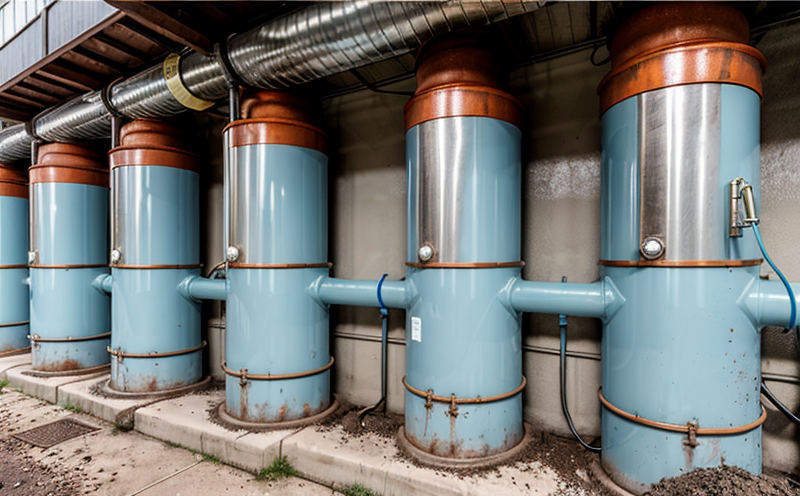ASTM G209 Microbiologically Influenced Corrosion Test in Water
The ASTM G209 test method is a critical tool used to evaluate the susceptibility of metals and alloys to microbiologically influenced corrosion (MIC) in water systems. This method is widely recognized for its ability to simulate real-world conditions, providing insights into how microorganisms can affect the integrity of materials used in plumbing, industrial, and potable water systems.
Microbiologically Influenced Corrosion occurs when microorganisms interact with metals and create an environment conducive to corrosion. This phenomenon is particularly challenging due to its unpredictable nature and variable impact across different environments. ASTM G209 addresses this challenge by providing a standardized approach to testing, ensuring consistency and reliability in the results.
The test method involves exposing metal coupons or specimens to water containing microorganisms under controlled conditions. The goal is to observe any changes in the physical properties of the material over time, such as weight loss, pitting, or other signs of corrosion. This information helps engineers and quality managers make informed decisions about material selection, design improvements, and maintenance strategies.
A key aspect of ASTM G209 is its focus on real-world conditions. The test method includes parameters such as temperature, water pH, and microbial activity levels that closely mimic the environments where MIC occurs. This ensures that the results are relevant to actual field conditions, allowing for more accurate predictions about material performance.
Another important feature of ASTM G209 is its adaptability. It can be used with a wide range of materials, including stainless steel, copper, aluminum, and various alloys. This versatility makes it a valuable tool across multiple industries, from water treatment facilities to industrial manufacturing plants.
The ASTM G209 test method is not only beneficial for material selection but also for process optimization. By identifying which materials are most susceptible to MIC, companies can implement targeted strategies to mitigate corrosion risks. This reduces maintenance costs and extends the lifespan of critical infrastructure components.
Furthermore, ASTM G209 helps in compliance with regulatory requirements by providing a standardized method for testing that meets international standards like ISO 17854 and EN 16372. Compliance is essential for maintaining operational permits and ensuring safety in water systems.
In summary, the ASTM G209 test method offers a comprehensive approach to evaluating microbiologically influenced corrosion in water systems. Its real-world relevance, adaptability, and compliance with international standards make it an indispensable tool for quality managers, compliance officers, R&D engineers, and procurement professionals working in this sector.
Applied Standards
| Standard | Description |
|---|---|
| ASTM G209 | The standard test method for determining the susceptibility of metals and alloys to microbiologically influenced corrosion (MIC) in water. |
| ISO 17854 | International standard for evaluating MIC resistance of metallic materials used in drinking water systems. |
| EN 16372 | European standard addressing the microbiological aspects of water quality and their impact on material integrity. |
Scope and Methodology
The ASTM G209 test method is designed to evaluate materials' resistance to MIC in water systems. The scope includes the preparation of specimens, the selection of microorganisms, and the exposure conditions that simulate real-world environments.
- Specimen Preparation: Metal coupons or plates are cut from various alloys and cleaned according to ASTM G209 specifications.
- Microorganism Selection: Specific strains of bacteria known to cause MIC in water systems are selected for the test. These include Pseudomonas aeruginosa, Sulfate-reducing bacteria (SRB), and others.
- Water Preparation: Water used in the test must meet certain quality criteria, including pH, conductivity, and microbial content. This water is inoculated with selected microorganisms before exposure to specimens.
- Exposure Conditions: Specimens are exposed to the prepared water under controlled conditions for a specified duration. Temperature, humidity, and other factors can be adjusted based on the specific requirements of the test.
The methodology involves regular monitoring and recording of any changes in the specimens' physical properties. This includes measuring weight loss, surface roughness, and the extent of pitting or corrosion. The results are compared against baseline data to determine the susceptibility of each material to MIC.
After exposure, the specimens undergo a series of analyses to confirm the presence and impact of MIC. These analyses may include visual inspections, metallographic examinations, and chemical analysis. The findings from these analyses help in understanding the mechanisms of corrosion and inform future material selection and design decisions.
Customer Impact and Satisfaction
- Improved Material Selection: By identifying materials susceptible to MIC, customers can make informed choices that enhance the durability and reliability of their products.
- Enhanced Process Optimization: Understanding MIC behavior allows for targeted improvements in manufacturing processes, leading to more efficient and cost-effective production.
- Better Compliance: The standardized approach provided by ASTM G209 ensures compliance with international standards, simplifying the regulatory process.
- Reduced Maintenance Costs: Early identification of corrosion-prone materials helps in implementing preventive maintenance strategies, reducing operational costs and downtime.
- Extended Lifespan of Infrastructure: By selecting materials resistant to MIC, customers can extend the lifespan of critical infrastructure components, such as pipes and fittings.





